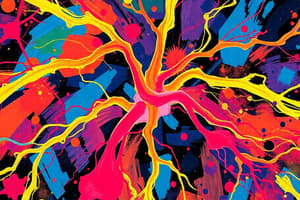Podcast
Questions and Answers
What is the primary function of nociceptors in the body?
What is the primary function of nociceptors in the body?
- To regulate body temperature
- To control muscle movement
- To detect and respond to painful stimuli (correct)
- To detect and respond to non-painful stimuli
Which type of nociceptor responds to multiple types of stimuli, including mechanical, thermal, and chemical?
Which type of nociceptor responds to multiple types of stimuli, including mechanical, thermal, and chemical?
- Thermoreceptors
- Polymodal receptors (correct)
- Osmoreceptors
- Mechanoreceptors
What is the minimum intensity of stimulation required to activate a nociceptor?
What is the minimum intensity of stimulation required to activate a nociceptor?
- Duration
- Frequency
- Threshold (correct)
- Amplitude
Which neurotransmitter is released by nociceptors and plays a key role in transmitting pain signals?
Which neurotransmitter is released by nociceptors and plays a key role in transmitting pain signals?
What is the primary pathway for pain transmission from the spinal cord to the brain?
What is the primary pathway for pain transmission from the spinal cord to the brain?
What is the term for the enhancement of pain transmission through mechanisms such as wind-up and central sensitization?
What is the term for the enhancement of pain transmission through mechanisms such as wind-up and central sensitization?
Flashcards are hidden until you start studying
Study Notes
Nociception
Definition: Nociception is the process by which the body detects and responds to painful stimuli.
Types of Nociceptors:
- Mechanoreceptors: respond to mechanical stimuli, such as pressure and vibration
- Thermoreceptors: respond to temperature changes
- Polymodal receptors: respond to multiple types of stimuli, including mechanical, thermal, and chemical
Nociceptor Activation:
- Threshold: the minimum intensity of stimulation required to activate a nociceptor
- Transduction: the conversion of a stimulus into an electrical signal
- Transmission: the transmission of the electrical signal to the spinal cord and brain
Neurotransmitters Involved in Nociception:
- Substance P: released by nociceptors, plays a key role in transmitting pain signals
- Glutamate: released by nociceptors, enhances pain transmission
- ** Bradykinin**: released by tissue damage, stimulates nociceptors
Pain Pathways:
- Spinothalamic tract: the primary pathway for pain transmission from the spinal cord to the brain
- Spinoreticular tract: a secondary pathway for pain transmission, involved in emotions and motivation
Modulation of Nociception:
- Inhibition: the reduction of pain transmission through mechanisms such as descending inhibition and opioid receptors
- Facilitation: the enhancement of pain transmission through mechanisms such as wind-up and central sensitization
Nociception
- Nociception is the process by which the body detects and responds to painful stimuli.
Types of Nociceptors
- Mechanoreceptors respond to mechanical stimuli, such as pressure and vibration.
- Thermoreceptors respond to temperature changes.
- Polymodal receptors respond to multiple types of stimuli, including mechanical, thermal, and chemical.
Nociceptor Activation
- The minimum intensity of stimulation required to activate a nociceptor is known as the threshold.
- Transduction is the conversion of a stimulus into an electrical signal.
- Transmission refers to the transmission of the electrical signal to the spinal cord and brain.
Neurotransmitters Involved in Nociception
- Substance P is released by nociceptors and plays a key role in transmitting pain signals.
- Glutamate is released by nociceptors and enhances pain transmission.
- Bradykinin is released by tissue damage and stimulates nociceptors.
Pain Pathways
- The spinothalamic tract is the primary pathway for pain transmission from the spinal cord to the brain.
- The spinoreticular tract is a secondary pathway for pain transmission, involved in emotions and motivation.
Modulation of Nociception
- Inhibition is the reduction of pain transmission through mechanisms such as descending inhibition and opioid receptors.
- Facilitation is the enhancement of pain transmission through mechanisms such as wind-up and central sensitization.
Studying That Suits You
Use AI to generate personalized quizzes and flashcards to suit your learning preferences.




